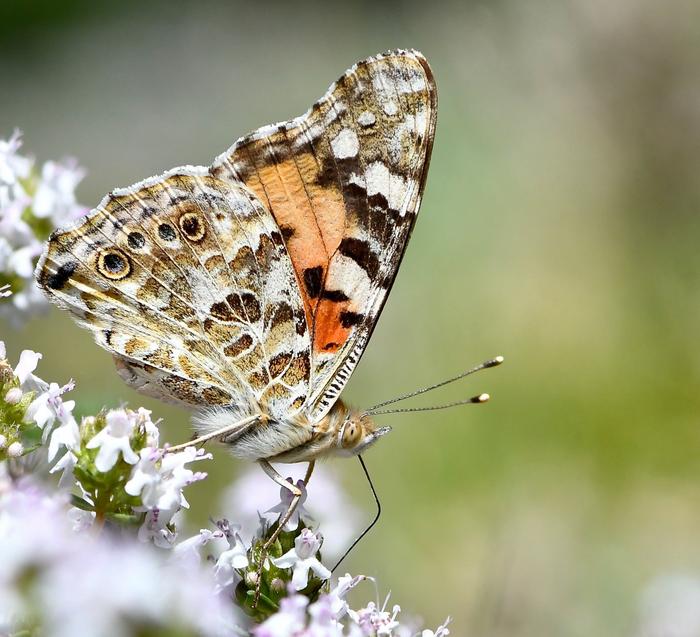In a remarkable study illuminating the migratory behavior of the painted lady butterfly, researchers have unveiled that environmental conditions—rather than genetic factors—play a pivotal role in determining migration strategies among these extraordinary insects. The painted lady butterfly, scientifically known as Vanessa cardui, is renowned for its striking beauty and impressive migration spanning thousands of kilometers each year. This butterfly’s unique ability to navigate vast distances has puzzled scientists for years, prompting an interdisciplinary collaboration that ultimately sought to decipher the underlying mechanisms governing their migratory patterns.
In essence, painted ladies undertake a monumental journey each year, migrating from Northwest Africa to various regions in Europe, including Sweden. The journey is substantial, covering approximately 10,000 kilometers—remarkable for an insect. This seasonal pilgrimage occurs through multiple generations, with each successive cohort contributing to the grand adventure. In a meticulously orchestrated manner, butterflies seemingly coordinate their travel routes to find optimal breeding conditions. Yet, this begs the question: what drives some individuals to embark on longer journeys while others opt for shorter migrations?
A team of scientists, including Daria Shipilina from the Institute of Science and Technology Austria (ISTA), initiated field studies across diverse geographical regions, aiming to unravel the intricacies behind these varying migration strategies. Utilizing a combination of isotopic geolocation techniques and advanced genetic analysis, the research provided illuminating insights into the painted lady’s remarkable adaptability, demonstrating that the butterflies tailor their migratory behavior in response to fluctuating environmental circumstances.
During field excursions in June within the scenic Catalan mountains, scientists hunted for painted ladies, displaying astounding determination and agility while attempting to capture these swift and spirited insects. The challenge of capturing a butterfly is akin to chasing a wisp of air; they dart through the sky with remarkable speed and unwavering resolve. After diligent efforts, the scientists finally succeeded in netting a painted lady, signifying a breakthrough moment for their ongoing study into these migratory marvels.
Analyzing captured individuals from regions both north and south of the Sahara, the research team focused on understanding geographical origins through isotopic composition analysis. By studying the distinct isotopic signatures present in butterfly wings—crafted from the plants consumed during their caterpillar stages—the scientists could trace the origins of these remarkable insects, revealing critical information about their migratory routes.
Throughout their analyses, the researchers identified a spectrum of migratory behaviors: some painted ladies undertook prolonged journeys southward, while others remained confined to the Mediterranean region. Interestingly, it became apparent that despite these distinct migratory patterns, genetic analysis yielded surprising results. By conducting whole genome sequencing across several butterflies, it was found that there were no significant genetic differences between those undertaking short and long migrations. This fundamental discovery contrasts sharply with observations in other migratory species, such as birds, where distinct genetic markers often indicate specific migratory behaviors.
The absence of genetic differentiation among the migratory painted ladies suggests a fascinating phenomenon known as phenotypic plasticity. This evolutionary adaptability allows organisms to adjust their behavior and traits in response to environmental stimuli without altering their underlying genetic structure. In the case of these butterflies, external factors—such as seasonal variations and changes in day length—are likely catalysts for their migratory tendencies.
For instance, the mosquitoes drifting along the coasts of Southern France may not sense the urgency to migrate long distances due to milder environmental cues. In contrast, painted ladies in Sweden may feel compelled to undertake significant southern migrations when days shorten and seasons shift. This inherent ability to respond to environmental triggers provides painted ladies with flexible strategies for survival and reproduction, demonstrating a remarkable evolutionary advantage.
As scientists delve deeper into this enigmatic migratory pattern, the painted lady butterfly continues to intrigue researchers worldwide. As one of the most widespread butterfly species, they offer a unique opportunity to understand how environmental changes drive animal behaviors. The questions surrounding the painted lady’s impressive migrations remain, leaving further research avenues open. Are there additional phenotypic adaptations across different populations? Could similar migratory behavioral traits manifest in other insect species, thereby converging to reveal shared evolutionary pathways?
In summary, the painted lady butterfly raises crucial questions about the influence of environmental conditions on migratory behavior in the animal kingdom. The ongoing research, driven by curiosity and scientific rigor, stands at the intersection of genetics, ecology, and evolutionary biology, poised to contribute valuable insights into the complexities of migration among living organisms. As scientists endeavor to close existing knowledge gaps in this area, each new finding prunes the expansive tree of scientific inquiry, one leaf at a time.
The study’s implications reach beyond the painted lady butterfly. They cast light on broader ecological principles that govern migration patterns in various species, fostering discussions about climate change, adaptation, and conservation efforts. It is imperative to grasp how fluctuating environmental conditions shape animal behavior now more than ever, especially in a world increasingly influenced by anthropogenic factors. The painted lady—once perceived merely as a beautiful butterfly—now emerges as a profound emblem of scientific exploration and a symbol of nature’s resilience amid changing dynamics.
As the research progresses, it will inevitably raise further questions, painting an intricate picture of life in flux—one in which each organism contributes to a greater understanding of our world. With every butterfly captured and every result analyzed, the story of the painted lady’s journey becomes not just a tale of migration but a testament to the evolutionary forces shaping life on Earth.
Subject of Research: Animals
Article Title: Isotope geolocation and population genomics in Vanessa cardui: Short- and long-distance migrants are genetically undifferentiated
News Publication Date: 4-Feb-2025
Web References: http://dx.doi.org/10.1093/pnasnexus/pgae586
References: N/A
Image Credits: © Niclas Backström
Keywords: Migration, Phenotypic plasticity, Isotope geolocation, Vanessa cardui, Animal behavior, Adaptation, Ecology, Evolution, Genetic analysis, Butterfly migration, Environmental influence, Scientific collaboration.




